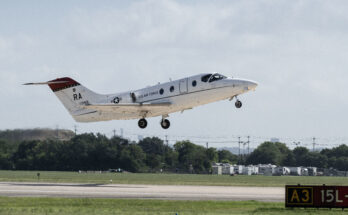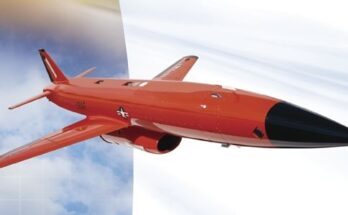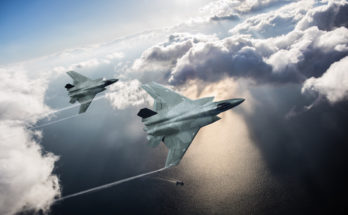by Andy Oppenheimer, Military Periscope

As the world faces another full-scale war in the Middle East, and the Ukraine conflict continues with little sign of conclusion, lurking beneath the international radar are new developments in nuclear weapons by the United States, Russia and China
During the Cold War, the U.S. nuclear stockpile increased in size and varieties of weapon. In the current century, the U.S. Department of Defense (DoD) and House of Representatives became increasingly concerned there was no reliable capability to produce a sufficient number of plutonium cores — “pits” – the central, key component of all the thermonuclear two-stage warheads that form the nation’s nuclear deterrent force.
Specifically, pits are hollow plutonium cores of the “primaries” (triggers) for the fission device that is incorporated within the thermonuclear weapon to, in simple terms, set it off.
In 2018, the National Nuclear Security Administration (NNSA) – the agency responsible for the production and maintenance of the nuclear stockpile – formulated a crash plan to build pit production lines at the Los Alamos National Laboratory (LANL) in New Mexico and the Savannah River Site (SRS) in South Carolina, with a combined annual output of 80 pits.
A New Role For Los Alamos
On the remote Pajarito Plateau, northern New Mexico, sprawls the world’s most extensive nuclear weapons laboratory – built during World War II around the small high-desert town of Los Alamos. As the scientific research heart of the wartime Manhattan Project, the rapidly constructed facility progressed from building the first atomic bombs that were dropped on Hiroshima and Nagasaki at the war’s conclusion to – along with Lawrence Livermore NL in California – developing and refashioning warheads for the U.S. nuclear arsenal from then to the present day.
Eight decades on, LANL is being regenerated for its prime role in modernizing the United States’ nuclear warheads inventory. The biggest and most ambitious program since the Manhattan Project, the new pit production initiative has required the hiring of some 3,300 workers since 2021, upping the total workforce to over 17,270.
The lab’s main role over many years has been maintenance of the nuclear stockpile. In this new project, under the direction of the NNSA, lab workers are preparing for renewed production of at least 30 plutonium pits per year by 2030.
Producing Plutonium
After the closure of the country’s prime plutonium manufacturing plant at Rocky Flats in 1992, where 1,000 to 2,000 pits were produced every year, a highly reinforced 236,000 sq-ft (21,925 sq-m) facility built at LANL earlier in 1978 became the first Department of Energy (DoE) facility capable of producing plutonium cores.
Although initially established for plutonium R&D, in 2003 the Plutonium Facility Building 4 (PF-4) at Los Alamos produced the nation’s stockpile quality (first war reserve) plutonium. The facility’s heavily reinforced concrete exterior walls, floor and roof are built to withstand extreme weather events and earthquakes.
In 2006, Congress instructed the DoE to focus on producing pits at this facility. Already being produced at LANL are “development pits,” which are pending requisite quality finalization to be incorporated in warheads.
Why Build More Pits?
The NNSA plan also includes replacing all 1,900 US SLBM (submarine-launched ballistic missile) warheads with new ones incorporating shock-resistant (“insensitive”) high explosive technology. This will make the warheads less prone to accidental detonation, which would disperse highly radioactive plutonium.
The NNSA proposes to first build 800 pits for new U.S. ICBMs (intercontinental ballistic missile) warheads deployed in 400 underground silos in various locations in the northern US Great Plains.
The current Minuteman III ICBM currently carries two warhead types, the W78 and W87. This is to be replaced by a new ICBM. The labs would like to replace the older W78 with an updated version of the W87, which has improved explosive sensitivity safety features.
The first 800 pits would equip the W87-1 warheads. These would take ten years to produce by the two NNSA proposed pit production facilities operating at full design capacity. The U.S. reportedly already has 540 W87 warheads which means one warhead on each of its 400 ICBMs.
Arms Control Concerns
Arms control advocates argue these efforts would only be necessary to increase the number of warheads on each ICBM from one to three. Previous administrations regarded this increase as destabilizing – partly because increasing the number of warheads on silo-based ICBMs would make them more vulnerable targets – as well as preventing compliance with the New START (Strategic Arms Reduction Treaty) with Russia – assuming that this agreement is extended in 2026.
There is also the inevitable question of cost. The original NNSA estimate in 2017 for a production capacity at the Savannah River facility to manufacture 80 warhead pits per year was $3.6 billion. This has since risen to $11.1 billion in 2023 – but to make only 50 pits annually.
The currently installed pits in the warheads inventory are estimated as 60 years or more, bringing arms control advocates at the Bulletin of Atomic Scientists to recommend that LANL prove it can produce 10-20 pits in a year before committing to further expense of building more production lines.
A Return To Nuclear Testing?
Added to these concerns are fears that the NNSA designs, as they are new, would need to be tested – leading to demands to resume nuclear tests. This would end the moratorium on all forms of nuclear testing – above and below ground – that has been observed since 1998 by all NWS (nuclear-weapon states) other than North Korea. The U.S. conducted its last underground test in 1992.
For some years now, computer modelling of nuclear weapon processes has replaced testing – and NNSA believes this highly advanced expertise will enable design of improved warheads without explosive nuclear tests. They also state that differences between old, tested warhead designs and new ones are minimal. There will still, however, be calls for renewed US testing if the reliability of the US stockpile is deemed to be at risk.
There are also claims that the pits have not aged enough to be replaced. Based on research at both national nuclear labs, an independent group of science advisors (the Jason Group) advised the U.S. administration in 2006 that the plutonium in existing pits would be functional for a hundred years.
Russia’s New Missiles
In early October, Russian President Vladimir Putin announced that his country had successfully tested an “experimental” nuclear-powered cruise missile – the Burevestnik (‘Storm Petrel’; NATO codename, Skyfall).
More alarming in terms of a new nuclear arms race, the Russian president also stated that Russia’s Sarmat heavy underground silo-based ICBM had completed its development stage. And according to Russia’s space agency Roscosmos, along with the Burevestnik the ICBM had “assumed combat duty.”
The Burevestnik is believed to be able to carry a nuclear warhead or a conventional one, and potentially could stay aloft for a much longer time than other missiles and cover a far greater distance, due to its nuclear propulsion.
NATO believed that a nuclear engine on a cruise missile would be highly unreliable. Both the U.S. and the Soviet Union shelved nuclear-powered rocket engines after attempting projects during the Cold War, as they were considered environmentally hazardous.
Far more recently – in August 2019 – this fear was borne out, when a Burevestnik reportedly exploded during tests at a Russian naval range on the White Sea. Five nuclear engineers and two servicemen were killed and a brief spike in radioactivity affected population in the area.
However, if the Burevestnik works as claimed by the Russians its nuclear propulsion would enable it to stay aloft far longer, and travel far further, than equivalent missiles.
A New Russian Situation
At the same time as rolling out his new missiles, Putin warned that ratification of the 1996 Comprehensive Nuclear Test Ban Treaty could be revoked by Russia. The U.S., unlike Russia, signed but did not ratify the CNTBT.
In April 2022, only weeks after his troops invaded Ukraine, Putin stated the Sarmat would “reliably ensure the security of Russia from external threats and make those, who in the heat of aggressive rhetoric try to threaten our country, think twice.”
With a range of some 11,000 miles (17,700 km), the Sarmat is estimated by the U.S. DoD to carry as MIRV (multiple independently targetable re-entry vehicles) ten warheads, not the 15 claimed by the Russians. Sarmat was test-fired in April 2022 in the Plesetsk region around 500 miles north of Moscow and hit targets on the far-eastern Kamchatka peninsula.
Mired in the Ukraine War with Russia’s – and Putin’s – internal solidarity somewhat weakened since the notorious Wagner Group’s attempted coup, the possibility of nuclear escalation should not be overlooked.
Russia’s defense doctrine suggests it would launch a nuclear response to a similar attack – or even an attack with conventional weapons that “threaten the very existence of the Russian state.”
NATO is stronger than any time since the end of the Cold War and has added to its membership the formerly neutral states of Finland and potentially Sweden. Russia’s additional nuclear posturing, accompanying Putin’s protracted belligerence in Ukraine and possibly beyond, is encapsulated in a statement by Russian foreign affairs advisor Sergei Karaganov. He has stated that Moscow should ramp up its nuclear threats to “break the will of the West” or even launch a limited nuclear strike on European NATO allies if the West continues to support Ukraine.
Russian Cooperation With China
Increased cooperation between Russia and China is compounding the overall threat. During the Cold War, Soviet Russia was the main enemy and nuclear rival of the U.S., with China rapidly catching up in recent times to become a true superpower.
Nuclear collaboration between the two powers dates back to when the Soviet Union provided technical help and materials to China’s nascent nuclear weapons program in the 1950s.
Beijing now has more long-range missile launchers than the U.S. and is set to hold as many nuclear weapons as the U.S. does by 2035. However, the Chinese lack the basic ingredient for building up its stockpile: plutonium.
Russian support for China’s nuclear buildup includes supplying badly needed fuel for its new fast-breeder reactors, which produce plutonium. China is thought to have already purchased more than 25,000 kg (55,000 lb) of fuel worth $384 million from Russia’s state-owned nuclear corporation, Rosatom, since September 2022.
China had doubled its stockpile eight years earlier – by 2022 – than the DoD predicted and may speed up its buildup even faster with Russian help.
***
Much of the renewed U.S. nuclear weapons efforts may be said to be in response to the respective buildups by Russia and China. However, the production by the U.S. of plutonium cores at LANL will only at first produce enough to replace aging warhead components, rather than increase its inventory.
To counter these accelerating and increasingly linked Russian and Chinese nuclear threats, strengthening the nuclear deterrent is the obvious U.S. response to ensure at least its strategic equality against these decades-long adversaries. This may signal a new nuclear arms race, which may be unavoidable.
Sources: “Birthplace of atomic bomb braces for biggest mission since the Manhattan Project,” Associated Press, Sept. 24, 2023; “Dealing with a debacle: A better plan for US plutonium pit production,” Curtis T. Asplund and Frank von Hippel, Bulletin of the Atomic Scientists, April 27, 2023; “Plutonium infrastructure,” Alexa Henry, Los Alamos National Laboratory, July 19, 2023; “Putin says Russia tested nuclear-powered missile, warns of revoking ban on atomic tests,” PBS Newshour/Associated Press, October 5th, 2023; “Putin’s “bluff”: a cautionary note about underestimating the possibility of nuclear escalation in Ukraine,” Stephen J. Cimbala and Lawrence J. Korb, Bulletin of the Atomic Scientists, October 2, 2023; “Russia Helping China Speed Up Its Nuclear Buildup. U.S. Unprepared to Counter It.,” Patty-Jane Geller and Jack Kraemer, The Heritage Foundation, March 20th, 2023; “Russia puts advanced Sarmat nuclear missile system on ‘combat duty’,” Al Jazeera (Qatar), September 2nd, 2023.
For 50 years, Forecast International intelligence reports have been the aerospace and defense industry standard for accurate research, analysis, and projections. Our experienced analysts compile, evaluate, and present accurate data for decision makers. FI's market research reports offer concise analysis of individual programs and identify market opportunities. Each report includes a program overview, detailed statistics, recent developments and a competitive analysis, culminating in production forecasts spanning 10 or 15 years. Let our market intelligence reports be a key part of reducing uncertainties and mastering your specific market and its growth potential. Find out more at www.forecastinternational.com



